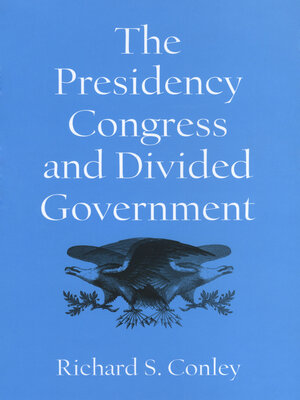The Presidency, Congress, and Divided Government
ebook ∣ A Postwar Assessment · Joseph V. Hughes Jr. and Holly O. Hughes Series on the Presidency and Leadership
By Richard S. Conley

Sign up to save your library
With an OverDrive account, you can save your favorite libraries for at-a-glance information about availability. Find out more about OverDrive accounts.
Find this title in Libby, the library reading app by OverDrive.



Search for a digital library with this title
Title found at these libraries:
| Library Name | Distance |
|---|---|
| Loading... |
Can presidents hope to be effective in policy making when Congress is ruled by the other party? Political scientist Richard Conley brings to this crucial discussion a fresh perspective. He argues persuasively that the conditions of divided government have changed in recent years, and he applies a rigorous methodology that allows the testing of a number of important assumptions about party control of the legislative process and the role of the president.
Conley demonstrates that recent administrations have faced a very different playing field than those in the earlier post-war years because of such critical developments in electoral politics as decreasing presidential coattails and the lack of presidential popularity in opposition members' districts. Moreover, he identifies several changes in the institutional setting in Congress that have affected both the legislative success rates of presidents' programs and the strategies presidents pursue. These institutional factors include more assertive legislative majorities, changes in leadership structure, and increased party cohesion in voting.
Conley uses both case studies and sophisticated time-series regression analyses to examine the floor success of presidential initiatives, the strategies presidents use in working with the legislature, and the use of veto power to achieve presidential aims.
Scholars of the presidency and those interested in the larger American political process will find in this book both food for thought and a model of analytic sophistication.
Conley demonstrates that recent administrations have faced a very different playing field than those in the earlier post-war years because of such critical developments in electoral politics as decreasing presidential coattails and the lack of presidential popularity in opposition members' districts. Moreover, he identifies several changes in the institutional setting in Congress that have affected both the legislative success rates of presidents' programs and the strategies presidents pursue. These institutional factors include more assertive legislative majorities, changes in leadership structure, and increased party cohesion in voting.
Conley uses both case studies and sophisticated time-series regression analyses to examine the floor success of presidential initiatives, the strategies presidents use in working with the legislature, and the use of veto power to achieve presidential aims.
Scholars of the presidency and those interested in the larger American political process will find in this book both food for thought and a model of analytic sophistication.







